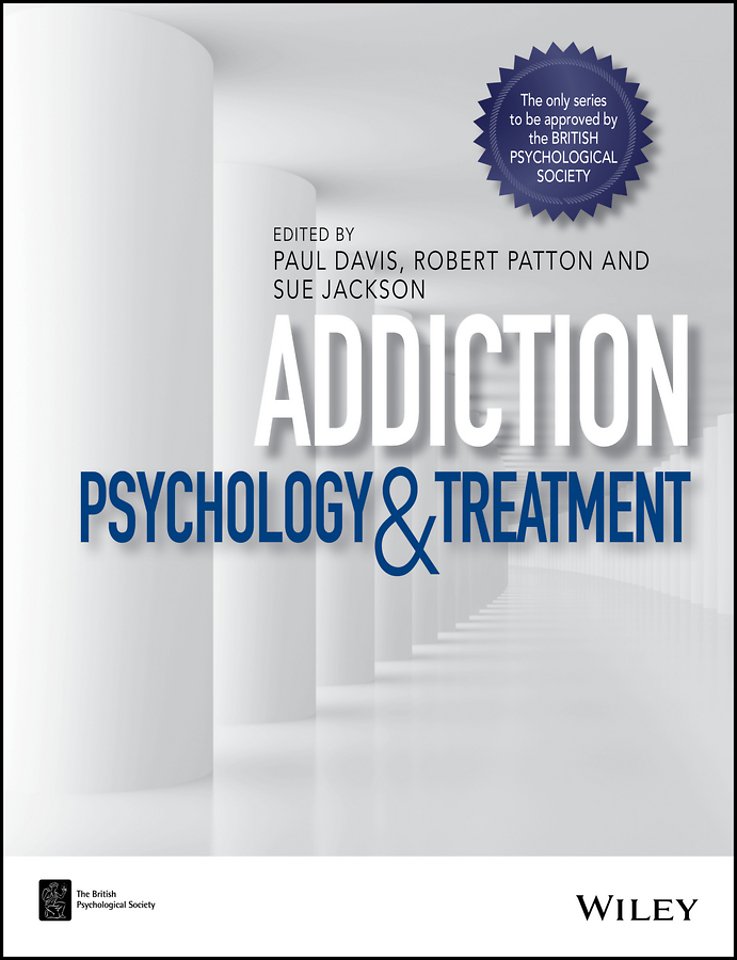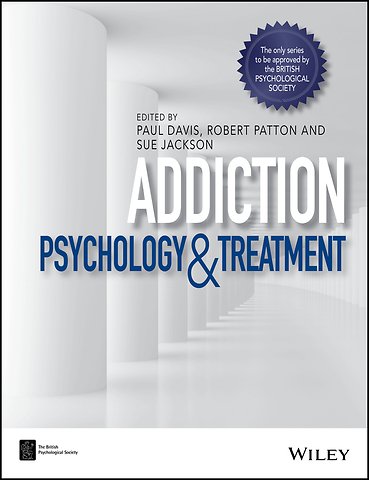Addiction – Psychology and Treatment
Psychology and Treatment
Samenvatting
Addiction: Psychology and Treatment brings together leading psychologists to provide a comprehensive overview of the psychology of addictions and their treatment across specialities and types of services.
Emphasises the use of several approaches including CBT, psychodynamic and systemic and family treatments, and consideration of the wider picture of addictions
As well as the theories, gives a clear overview of the application of these models
Reflects the very latest developments in the role played by psychological perspectives and interventions in the recovery agenda for problem drug and alcohol users
Specificaties
Inhoudsopgave
<p>Foreword xiii</p>
<p>Preface xvii</p>
<p>Notes on Contributors xix</p>
<p>PART 1 Understanding the Psychology and Treatment of Addictions 1</p>
<p>CHAPTER 1 Addiction: A Comprehensive Approach 3<br />Jamie Brown and Robert West</p>
<p>1.1 Introduction 4</p>
<p>1.2 Existing theories 5</p>
<p>1.3 The human motivational system 8</p>
<p>1.4 Internal and external sources of influence 11</p>
<p>1.5 The dynamics of the system 12</p>
<p>1.6 Changing dispositions 14</p>
<p>1.7 Testing the theory 15</p>
<p>Suggestions for further reading 16</p>
<p>References 16</p>
<p>CHAPTER 2 An Attachment–Informed Approach to Working with Addiction 20<br />David Curran and Mani Mehdikhani</p>
<p>2.1 Introduction to attachment 21</p>
<p>2.2 Attachment and psychopathology 23</p>
<p>2.3 Attachment and addiction 25</p>
<p>2.4 Attachment styles in clinical samples 28</p>
<p>2.5 Assessment and formulation through an attachment lens 29</p>
<p>2.6 Treatment implications 32</p>
<p>2.7 Conclusion 35</p>
<p>Suggestions for further reading 35</p>
<p>References 36</p>
<p>CHAPTER 3 Families, Friends and Addiction: Impacts, Psychological Models and Interventions 42<br />Alex Copello and Kathryn Walsh</p>
<p>3.1 Introduction 43</p>
<p>3.2 The composition of alcohol and drug users social networks 43</p>
<p>3.3 Impacts of addictions on others 44</p>
<p>3.4 Theoretical models of addiction and the family: stress–strain–coping–support 47</p>
<p>3.5 From models to interventions 48</p>
<p>3.6 Conclusion 52</p>
<p>Suggestions for further reading 53</p>
<p>References 54</p>
<p>CHAPTER 4 Working Systemically with Alcohol Misuse 57<br />Arlene Vetere and Rudi Dallos</p>
<p>4.1 Introduction 58</p>
<p>4.2 Family life 59</p>
<p>4.3 Family systems approaches 60</p>
<p>4.4 Working therapeutically with violence and abuse 64</p>
<p>4.5 Engagement and the therapeutic relationship 65</p>
<p>4.6 Conclusion 66</p>
<p>Suggestions for further reading 66</p>
<p>References 67</p>
<p>CHAPTER 5 Dangerous Desires and Inanimate Attachments : Modern Psychodynamic Approaches to Substance Misuse 68<br />Martin Weegmann and Edward J. Khantzian</p>
<p>5.1 Introduction 69</p>
<p>5.2 Primitive emotional states: Kleinian views 70</p>
<p>5.3 Comforting self–objects: Kohutian views 72</p>
<p>5.4 Inanimate attachments: Bowlbian views 74</p>
<p>5.5 Bringing it together: addiction as a disorder of self–regulation 76</p>
<p>5.6 Reflective practice 78</p>
<p>5.7 Internal recovery 79</p>
<p>5.8 Conclusion 81</p>
<p>Suggestions for further reading 82</p>
<p>References 82</p>
<p>CHAPTER 6 Mindfulness, Acceptance and Values in Substance Misuse Services 84<br />Liz McGrath and Dominic O Ryan</p>
<p>6.1 Introduction: what are the principles and methods of mindfulness, acceptance and values? 85</p>
<p>6.2 How does ACT integrate with other approaches? 87</p>
<p>6.3 How does the service use these principles and methods of ACT? 90</p>
<p>6.4 How do mindfulness, acceptance and values support the resilience of staff in the face of seemingly<br />relentless relapse and other behaviours? 92</p>
<p>6.5 What are the experiences of staff working with ACT? 94</p>
<p>6.6 What are the experiences of clients working this way? 96</p>
<p>6.7 Our experience of ACT 97</p>
<p>Suggestions for further reading 98</p>
<p>References 98</p>
<p>PART 2 Clinical Applications of Addiction Psychology 103</p>
<p>CHAPTER 7 The Role of Clinical Psychology within Alcohol Related Brain Damage 105<br />Fraser Morrison and Jenny Svanberg</p>
<p>7.1 Introduction 106</p>
<p>7.2 Clinical definition of alcohol–related brain damage and related syndromes 106</p>
<p>7.3 Epidemiology of ARBD and related syndromes 107</p>
<p>7.4 Cognitive function in ARBD 108</p>
<p>7.5 Psychosocial and cognitive rehabilitation 111</p>
<p>7.6 Legal framework: mental capacity 117</p>
<p>7.7 Recovery 118</p>
<p>Suggestions for further reading 119</p>
<p>References 119</p>
<p>CHAPTER 8 Trauma and Addiction 124<br />David Curran</p>
<p>8.1 Psychological trauma and PTSD 125</p>
<p>8.2 The relationship between addiction and psychological trauma 127</p>
<p>8.3 Assessment 129</p>
<p>8.4 Treatment of co–existing trauma and substance use disorders 131</p>
<p>8.5 Clinical implications 135</p>
<p>8.6 Conclusion 139</p>
<p>Suggestions for further reading 139</p>
<p>References 139</p>
<p>CHAPTER 9 Narrative Identity and Change: Addiction and Recovery 144<br />Martin Weegmann</p>
<p>9.1 Narrative theory 145</p>
<p>9.2 Narrative therapy 145</p>
<p>9.3 Narrative theory and addiction 146</p>
<p>9.4 Client talk 147</p>
<p>9.5 Generating narrative 149</p>
<p>9.6 Narratives of recovery 152</p>
<p>9.7 Varieties of recovery story 152</p>
<p>9.8 Conclusion 154</p>
<p>Acknowledgements 155</p>
<p>Notes 155</p>
<p>Suggestions for further reading 155</p>
<p>References 156</p>
<p>CHAPTER 10 Addiction and Mental Health 158<br />Adam Huxley</p>
<p>10.1 Introduction 159</p>
<p>10.2 Association between substance misuse and psychosis 160</p>
<p>10.3 Prevalence and epidemiology 162</p>
<p>10.4 Outcomes associated with co–occurring disorders 163</p>
<p>10.5 Treatment approach and effectiveness 163</p>
<p>10.6 Evidence for effectiveness 164</p>
<p>10.7 Conclusion 166</p>
<p>Suggestions for further reading 167</p>
<p>References 167</p>
<p>CHAPTER 11 Substance Misuse in Older Adults 172<br />Sarah Wadd and Tony Rao</p>
<p>11.1 Introduction 173</p>
<p>11.2 Definition of older adult 173</p>
<p>11.3 Alcohol 173</p>
<p>11.4 Illicit drug use 176</p>
<p>11.5 Medication misuse 178</p>
<p>11.6 Assessment of older people with substance misuse 179</p>
<p>11.7 Psychosocial interventions 184</p>
<p>11.8 Legal and ethical considerations 185</p>
<p>11.9 Using and evaluating health and social outcomes 186</p>
<p>11.10 Conclusion 187</p>
<p>Suggestions for further reading 188</p>
<p>References 188</p>
<p>CHAPTER 12 Issues Arising in Hepatitis C Work: The Role of the Clinical Psychologist 193<br />Jo M. Nicholson</p>
<p>12.1 Introduction 194</p>
<p>12.2 Hepatitis C background: the virus and treatment 194</p>
<p>12.3 Social and clinical characteristics of the HCV patient population 195</p>
<p>12.4 HCV treatment challenges 196</p>
<p>12.5 Pegylated Interferon–related adverse psychiatric side–effects 197</p>
<p>12.6 HCV–infected mental health populations 198</p>
<p>12.7 So what is the role of the psychologist? 200</p>
<p>12.8 Psychological stepped–care model in HCV treatment 206</p>
<p>12.9 Future challenge 208</p>
<p>12.10 Conclusion 208</p>
<p>Suggestions for further reading 209</p>
<p>References 209</p>
<p>CHAPTER 13 The Psychology and Treatment of Gambling Disorders 213<br />André Geel, Rebecca Fisher, and Aska Matsunaga</p>
<p>13.1 Introduction 214</p>
<p>13.2 Definition 214</p>
<p>13.3 Prevalence 215</p>
<p>13.4 Demographic risk factors 216</p>
<p>13.5 Treatment of gambling disorders 222</p>
<p>13.6 Personal comment and reflections 224</p>
<p>13.7 Conclusion 224</p>
<p>Suggestions for further reading 225</p>
<p>References 225</p>
<p>CHAPTER 14 Alcoholics Anonymous and 12 Step Therapy: A Psychologist s View 230<br />Martin Weegmann</p>
<p>14.1 Introduction: personal context 231</p>
<p>14.2 History 232</p>
<p>14.3 Philosophy 233</p>
<p>14.4 How does it work? 235</p>
<p>14.5 What can psychologist and helping professionals do? 239</p>
<p>14.6 Criticisms of AA 240</p>
<p>14.7 Postscript 241</p>
<p>Notes 241</p>
<p>Suggestions for further reading 242</p>
<p>References 242</p>
<p>CHAPTER 15 Relapse Prevention: Underlying Assumptions and Current Thinking 245<br />Robert Hill and Jennifer Harris</p>
<p>15.1 Introduction 246</p>
<p>15.2 What is relapse prevention? 246</p>
<p>15.3 Models of relapse prevention 250</p>
<p>15.4 Addressing co–existing mental health 254</p>
<p>15.5 Neuropsychological and associated difficulties when undertaking RP 255</p>
<p>15.6 Conclusion 257</p>
<p>Suggestions for further reading 258</p>
<p>References 259</p>
<p>CHAPTER 16 Working with Ambivalence about Change: Motivational Interviewing 262<br />Lisa Dutheil and Alina Galis</p>
<p>16.1 Introduction 263</p>
<p>16.2 Definition 263</p>
<p>16.3 Historical perspective 264</p>
<p>16.4 Theoretical influences 265</p>
<p>16.5 The spirit of MI 266</p>
<p>16.6 Change talk, sustain talk and discord 266</p>
<p>16.7 The four MI processes 267</p>
<p>16.8 Core MI skills 269</p>
<p>16.9 MI strategies more specific to particular processes 271</p>
<p>16.10 Evidence for the efficacy of MI 272</p>
<p>16.11 Integrating MI with other approaches 274</p>
<p>16.12 Using MI in groups 275</p>
<p>16.13 Learning MI 277</p>
<p>16.14 Conclusion 278</p>
<p>Suggestions for further reading 279</p>
<p>References 279</p>
<p>CHAPTER 17 Beyond Workshops : Turning Evidence for Psychosocial Interventions into Embedded Practice 284<br />Luke Mitcheson, Christopher Whiteley, and Robert Hill</p>
<p>17.1 Introduction 285</p>
<p>17.2 What is implementation? 285</p>
<p>17.3 Implementation science 287</p>
<p>17.4 Consolidated Framework for Implementation Research (CFIR; Damschroder et al., 2009) 287</p>
<p>17.5 Implement what? Evidence–based interventions versus evidence–based practices 292</p>
<p>17.6 Case studies in Motivational Interviewing and treatment effectiveness (Mapping) 294</p>
<p>17.7 Conclusion 298</p>
<p>Notes 300</p>
<p>Suggestions for further reading 300</p>
<p>References 300</p>
<p>Index 303</p>

